It’s Thursday, and we’re off to Mashhad. Or rather, Gorgan. Sounds a bit like a creature from Greek mythology, but Gorgan will only be a waystation on the road to the holiest city in Iran.
We say goodbye to Mr. Mousavi for a third and last time, before we get in the car towards Mashhad. Its about 1000 km from Tehran, and Gorgan is halfway there.
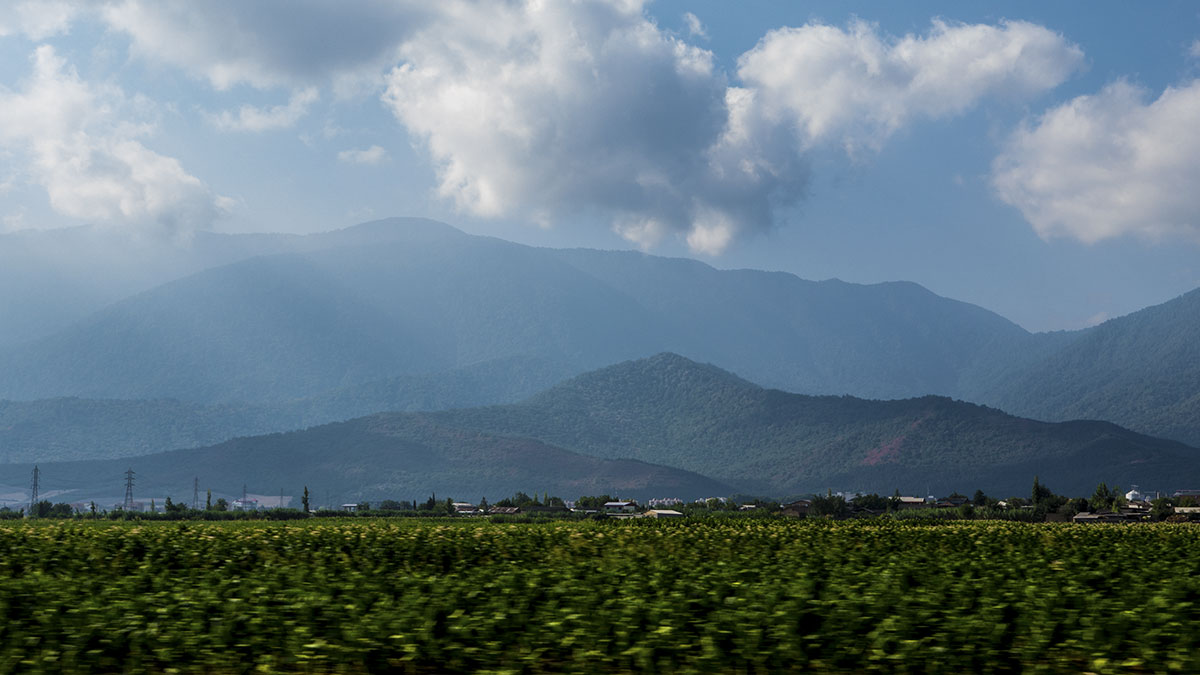
On the road to Mashhad
We’ve been advised to stay at the Hotel Pars in Gorgan, as it is reasonably priced and apparently has a tree growing in the middle of it.
Make of that what you will.
When we arrive at the hotel Pars, it seems alright. The young concierge spends half an hour showing us to the car park (we never would have found it without him). But then he leaves, and an older man takes over.
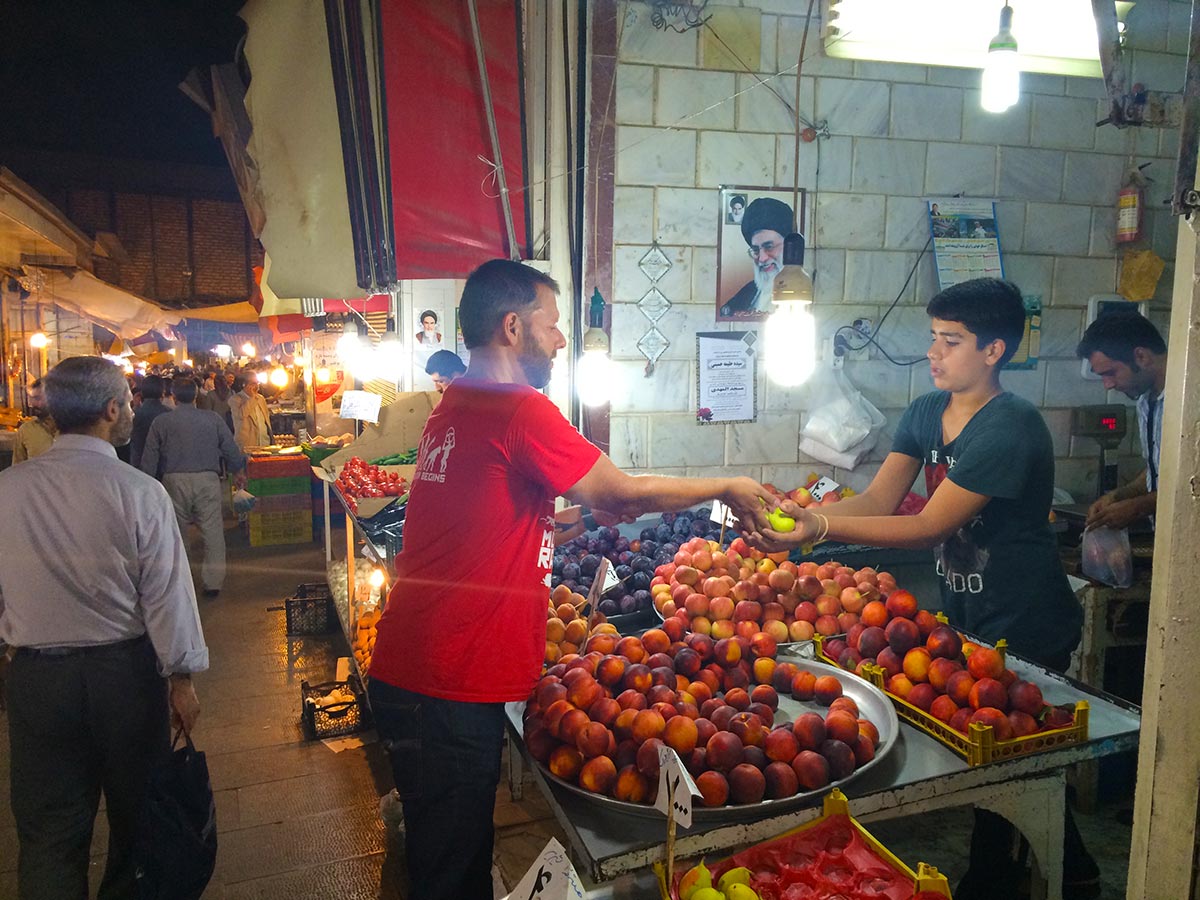
Lars buying fruit and pistachios
So we come back from a trip to the bazaar (where Lars bought fruit and a kilo of pistachios), and would like to sit in the orchard, under the famous fruit tree. When we try to explain to the guy manning the reception desk that we want to move som furniture outside (you know, chairs and things), he becomes agitated and starts mumbling about the police.
Whether this means that there is a police ordnance in Gorgan about moving furniture outside (there isn’t – we checked), or he just didn’t want any hassle we don’t know.
It doesn’t matter. We move the furniture and are soon joined in our late dinner of pistachios, yoghurt and fruit by Geneviève and Éliane, two lovely French ladies we had met in Tehran. After some talk about travelling in general, and travelling in Iran in particular, we say goodnight and let the girls have our shower key. Yeah, because it turns out the guy at the reception takes $1 for each shower before he hands you the key. The stall is locked normally, but he had given us the key when we arrived, so we are thinking of maybe funding our trip this way.
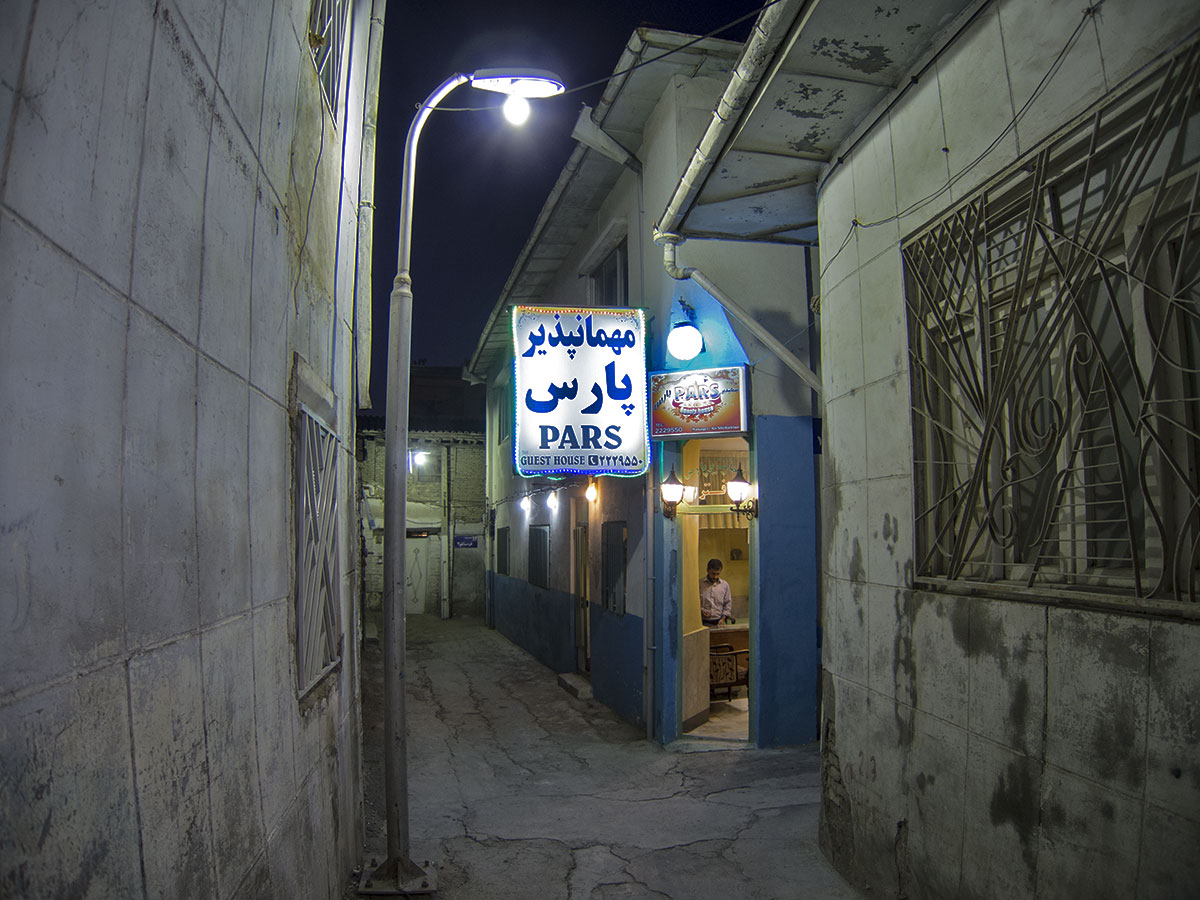
Hotel Pars in Gorgan – don't move the furniture
Our room the next day feels like the bottom of a swamp.
It’s hot and humid, and we don’t have any AC, only an old ceilling fan that moves the air around like a spoon in hot tea.
After taking two morning showers just to be able to function, we drive to Mashhad.
Mr. Mousavi at the Firouzeh Hotel in Tehran had recommended we stay at the Hotel Pars in Mashhad (wait a second), since it’s the oldest hotel in the city and reasonably priced.
As it turns out, «Pars» actually means «Persian», so it’s quite a common name for hotels and businesses in the country. That’s a relief.
When we arrive on Friday, it’s too late to do anything about the transit visa to Turkmenistan for Snorre. The earliest we can go to the consulate is on Sunday, since every office in Iran is closed on Friday and Saturday. So we settle into the hotel, which has a spacious but rundown lobby with wi-fi access. You can see that this hotel at one point must have been a nice place to stay – indeed the proud owner tells us that kings and statesmen used to stay here all the time. Not so much these days, it seems.
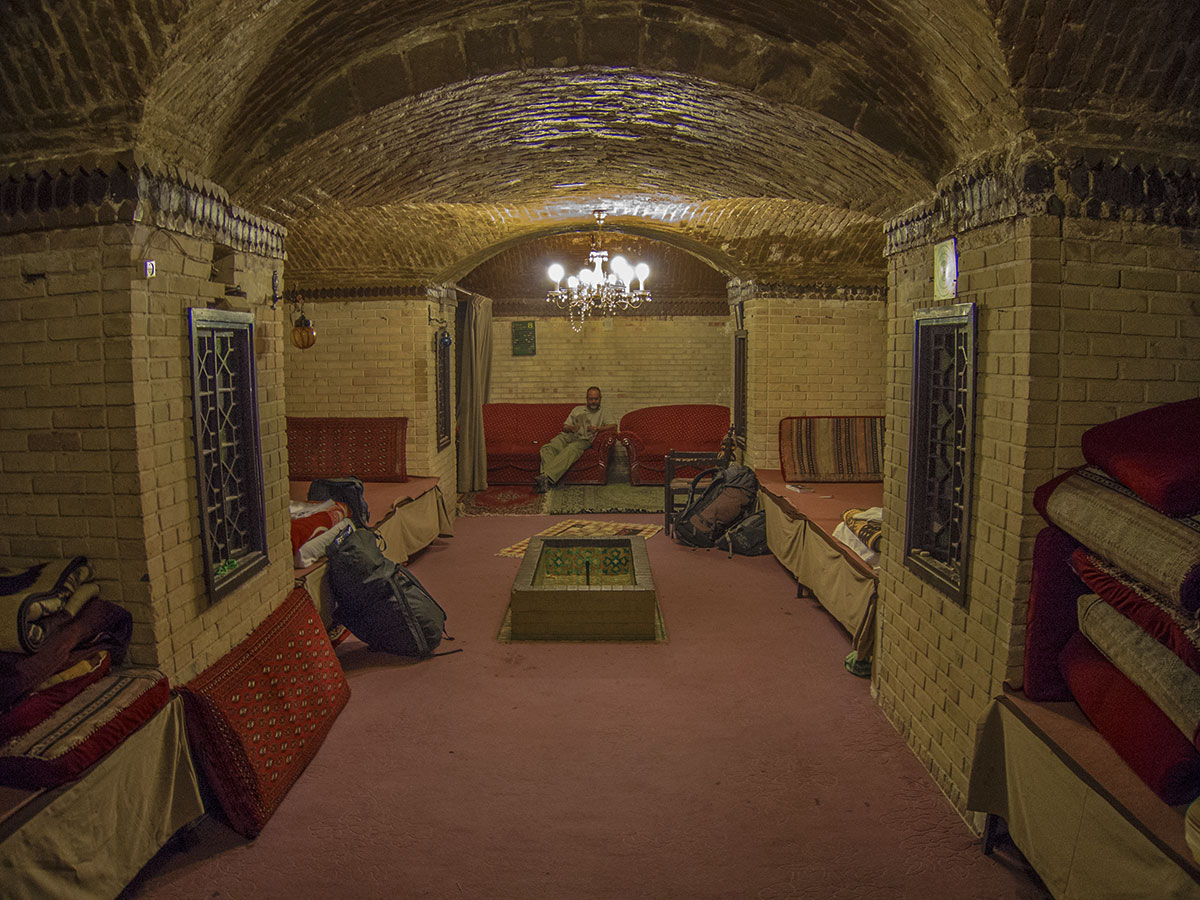
Our own catacombs for the night
We write some blogposts, download the pictures and videos of the trip from the cameras and basically sit in the lobby and drink tea.
After a while our room is ready: turns out we’ve been given what looks like underground catacombs, or at least the entire basement floor. Well, we don’t complain. There is a Western-style toilet (next to the Persian squat toilet), a shower and about 150 square meters of room with several spaces for beds and a fountain in the middle of it. Yes, a fountain.
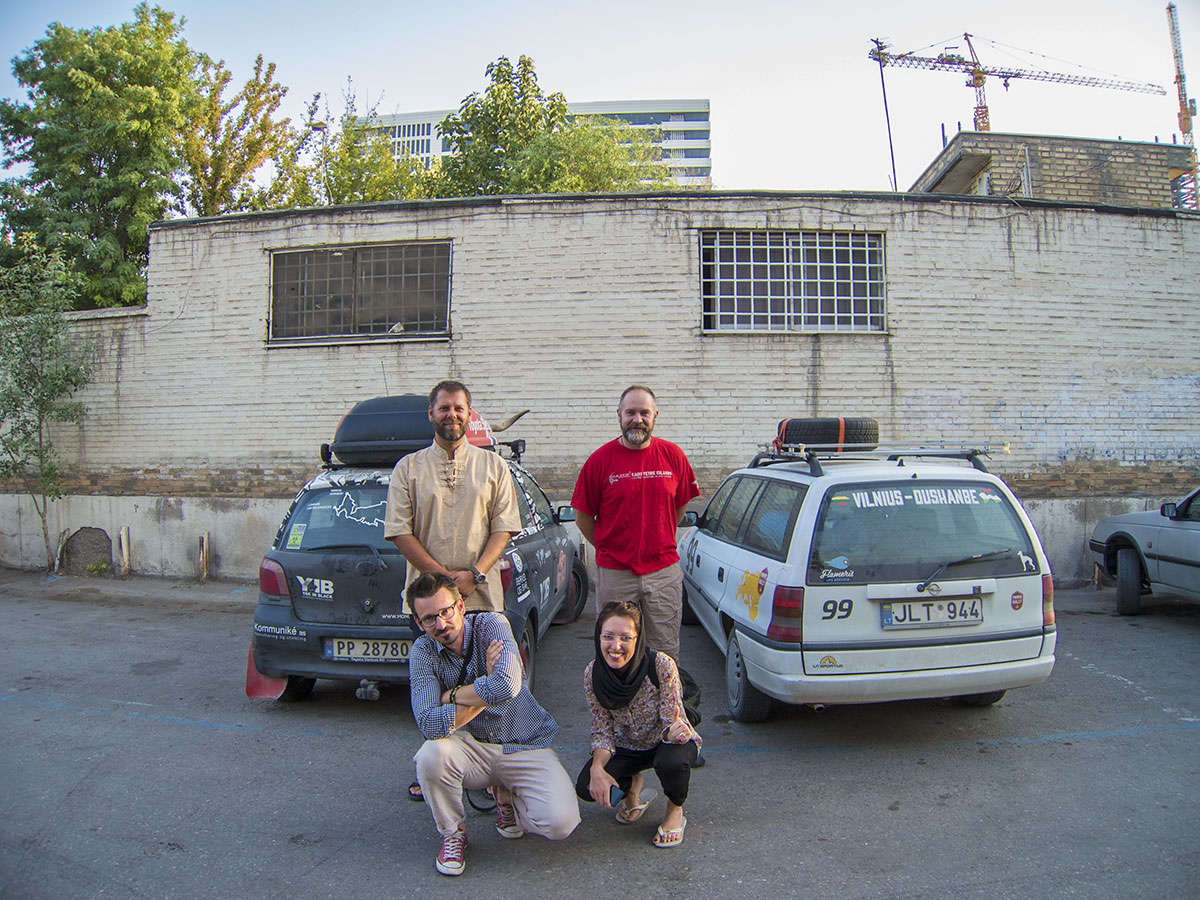
Team Vilnius-Dushanbe in Mashhad
When we go back to the lobby, we meet another team. Gintare, Vadim and Andrej are the only contestants in the Vilnius-Dushanbe rally and are staying at the same hotel as we are. They are planning to go and visit the Imam Reza Shrine. The shrine is a complex which contains the mausoleum of Imam Reza, the eighth Imam of Twelver Shi’ites. It is the largest mosque in the world. Also contained within the complex are the Goharshad Mosque, a museum, a library, four seminaries,a cemetery, the Razavi University of Islamic Sciences, a dining hall for pilgrims, vast prayer halls, and other buildings.
Thanks, Wikipedia.
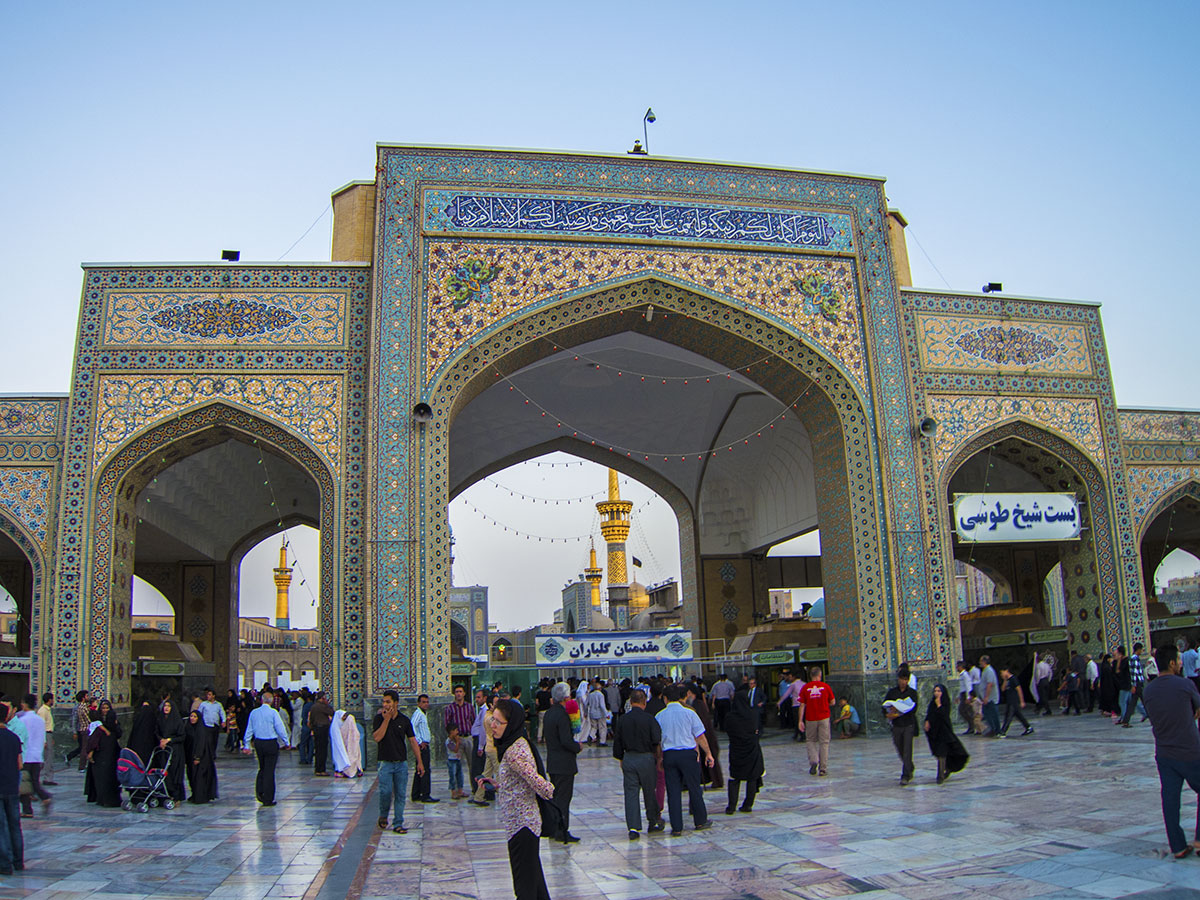
Outside the Imam Reza shrine
When we get to the shrine, lots of people are on their way in. This is not uncommon, but apparently we’ve arrived at a time that marks the death of one of the grandsons of Imam Reza. Thousands of people are streaming in to pay their respects.
So Gintare, Vadim, Snorre, Lars and Andrej are standing near the entrance, not sure what to do. Can we go in? Is it disrespectful to come at a time of mourning? Do they even want tourists here?

Team Vilnius-Dushanbe and Yak in Black
As it turns out, or worries are unfounded. The Iranian people once again prove their remarkable hospitality and after 5 minutes of waiting, a security guard has called an English-speaking guide. Just for us!
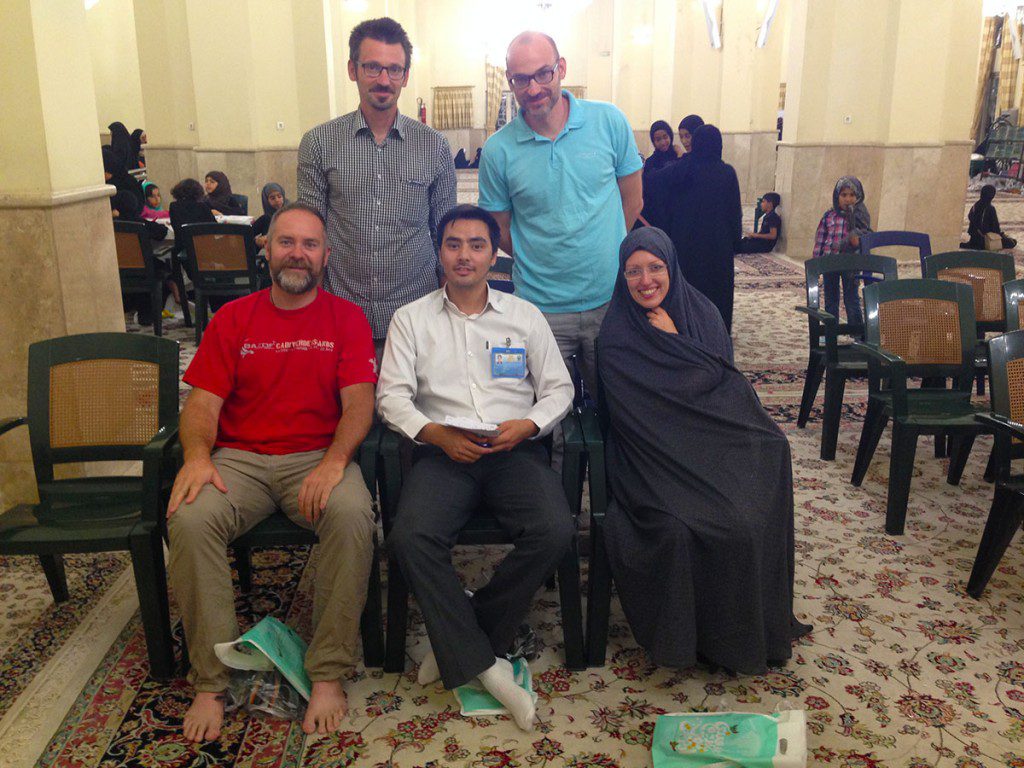
Our guide Sa'id at the Imam Reza Shrine
Sa’id is a civil engineer, and does the guided tours at the Imam Reza Shrine as a volunteer on the weekends; «to relax and do something different», he explains.
We start off by getting a chādor for Gintare, since women cannot enter the shrine without it. This has its roots as far back as the 6th century, when veiling was not limited to women but was practiced also by the Persian shahs.
Sa’id gets Gintare the chādor, gives us a once-over (shorts are not worn in Iran, so we’ve been using trousers for a while) and after we’ve handed over our cameras to the security guards, we go inside.
Where thousands of people are praying in the courtyards.

One of 8 courtyards in the Imam Reza shrine
This looks amazing. Everywhere you see, there are lovely Persian carpets on the marble ground. People all around us sit or kneel on them, after having taken off their shoes first. Men, women and children, old and young – it seems this is an opportunity to bring the entire family together for a few peaceful moments.

Inside the Imam Reza shrine
Sa’id tries to explain the meaning behind many of the things we see, and Snorre asks probing questions about language, customs and traditions. The rest of us look around us and wish we had our cameras. Sa’id notices us looking and pointing out things to each other; here are some beautiful tiles, and over there a portal that looks like it’s from the 16th century.
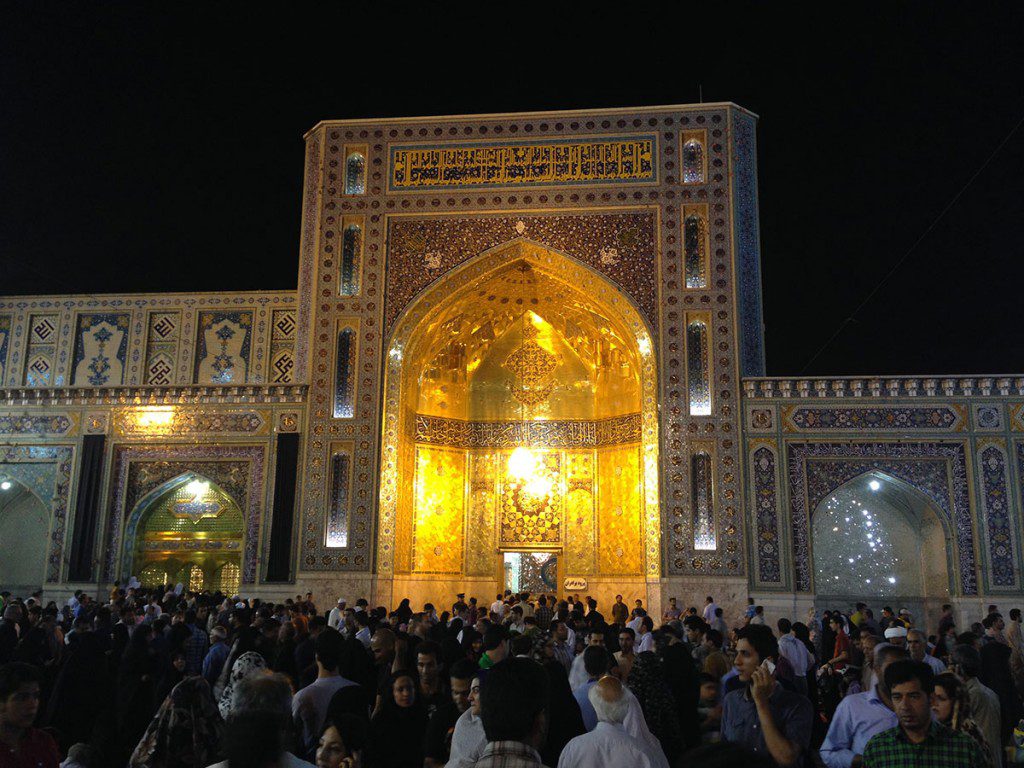
The next thing he says surprises us a bit: «Please, take pictures. It’s alright.» He means with our mobile phones. Apparently, it’s allowed.
We don’t have to be asked twice, and soon we fill up our memory cards with lovely images of people praying, children laughing and running around fountains, through magnificent portals embellished with new and old tiles side by side.

Sa’id takes us through the different courtyards (Sahn), which cover an area of over 331 578 square meters: there is Sahn Inqilab (the Revolution Courtyard), Sahn Azadi (the Freedom Courtyard), Sahn Imam Khomeini (he’s got quite a few things named after him in Iran), Sahn Gowharshad Mosque, Sahn Quds, Sahn Jumhuri Islami (the Islamic Republic Courtyard), Sahn Jameh Razavi (the Razavi Grand Courtyard) and Sahn Gadeer.
In addition to this, the courtyards also contain a total of 14 minarets, and 3 fountains.

Drinking fountain
After a couple of courtyards, Sa’id takes us into a room that either is a kindergarten or a classroom for children, since so many of them are sitting here; either drawing, talking to their friends or being entertained by grownups.

Inside the Imam Reza shrine
It turns out that we’re here, because Press TV (Iran’s Tehran-based television network, broadcasting in English) has made a documentary about the shrine, and we’re about to see it. Sa’id is anxious that we tell him what we think about the film, and if we have any comments or criticisms. Anything to make the experience better. We promise we will, and settle down for what turns out to be an 8-minute documentary.
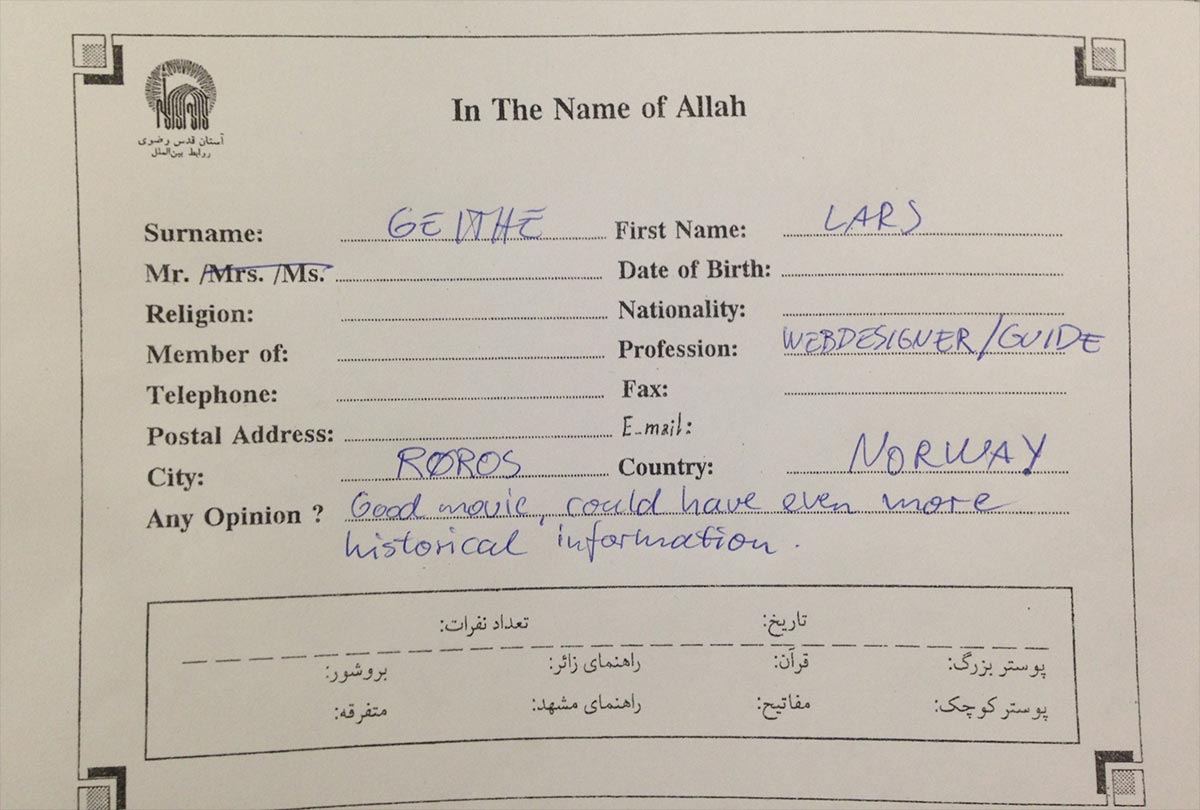
Your comments, please
After we’ve filled our note on the cards Sa’id has provided us, we get packets of tourist brochures with beautiful pictures of the shrine and some practical things: like a tourist map of Mashhad. Now, why didn’t we get that in Tehran?

One of the mirror rooms in the Imam Reza shrine
After two and a half hours of guided tour in the enormous shrine, Sa’id once again welcomes us to his country, and takes his leave.
The rest of us are pretty full from everything we’ve seen, and some go back to the hotel by taxi while Snorre and Lars decide to walk back and maybe get some food on the way.
It’s Sunday, and Snorre is off to get his Turkmenistan visa.
Which he doesn’t get until the next day, he’s told. Oh, well. We are getting used to this, so Sunday is spent writing blog posts, choosing which photos to publish, editing some video and more.
It’s late afternoon, and we’re still sitting in the lobby of the Pars Hotel, doing our thing. All of a sudden, a hand is thrust towards us and a thick Australian accent welcomes us to Iran.
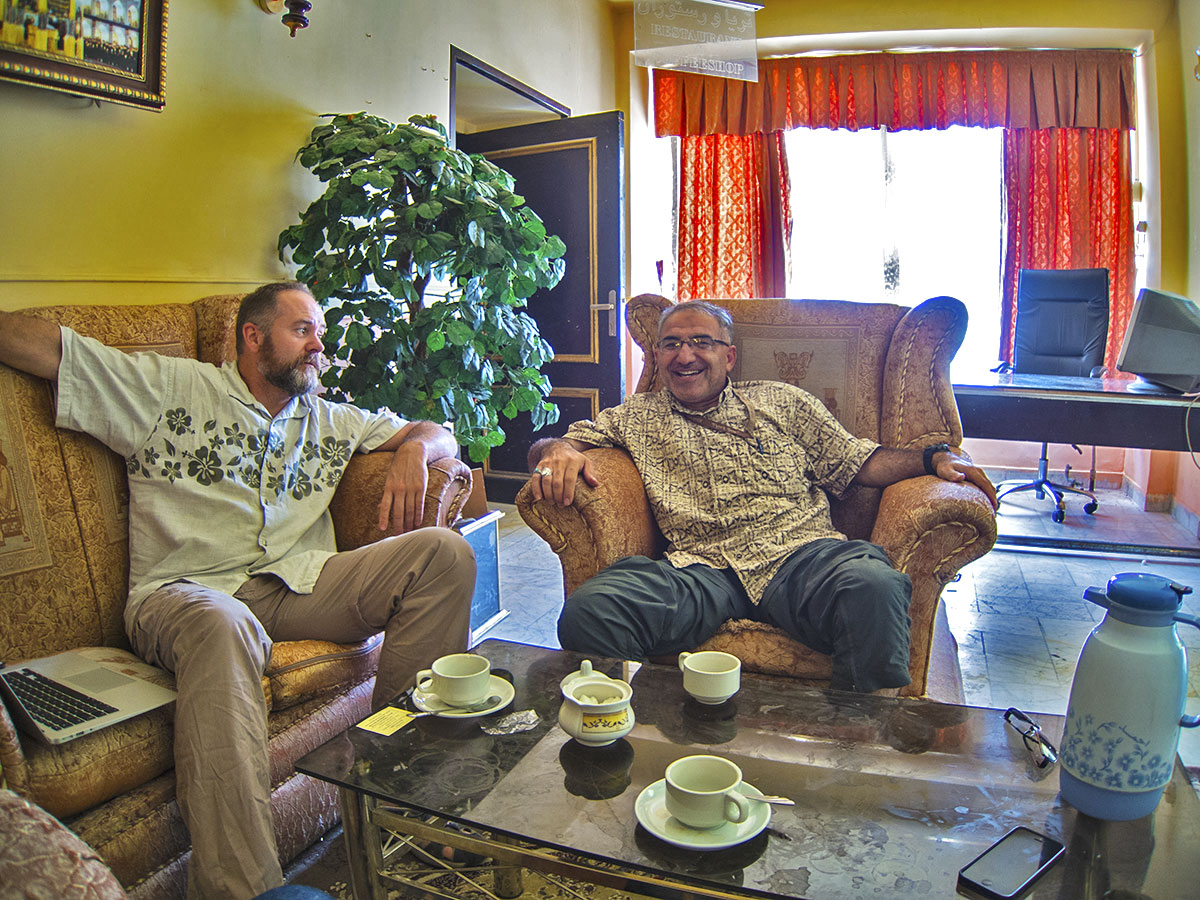
Rafi Khankhajeh, accredited driver-guide
Turns out the genial Rafi Khankhajeh, accredited driver-guide, isn’t Australian, and he never spent time there either. Alright then. What ensues is a two-hour conversation, spanning everything from how we like Iran, to the Mongol Rally, Rafi’s work in the tourism industry and the fact that he does sound Australian (no explanation as to why).
After a while, Snorre and Rafi make an agreement that Rafi will come back early on Monday morning to help Snorre with any language-based problems he might have at the Turkmen consulate. This is after he has driven Lars to the Mashhad International Airport for his flight to Dushanbe, Tajikistan.
At 4am.
Four o’clock rolls by, and on the dot Rafi comes bursting through the lobby doors. Lars had been waiting for half a minute wondering about whether his flight would be on time, what Dushanbe is like and whether his plane would crash and burn upon landing (something which had happened to the same ariline two weeks earlier). He is thrilled to hear this Persian’s Australian accent as he almost crashes through the two glass doors, and throws his luggage in Rafi’s car.
On the short trip to the airport they get to talk about the Iranian revolution, the unemployment in Iran (too high), and the fact that Rafi needs a new car (too small), since many of the tour groups that want to hire him are made up out of 6 people.
Lars and Rafi agree that most problems in the world stem from incompetent governments and politicians, not regular people who usually just want to go about their business and make a living.
This has been the sense we got pretty much everywhere we went on the rally.
They park in front of the airport. Lars hands out a Yak in Black business card together with a modest driver’s fee for Rafi, and they make their farewells.
Terminal 2 of the Shahid Hashemi Nejad Airport is situated in a 4-year old building made out of glass and stone. The airport is one of the country’s busiest, only second to Tehran Mehrabad Airport and Imam Khomeini International Airport. In 1392 (2013) the airport handled 7 321 371 passengers along with 65,685 tons of cargo. The terminal looks new, although as soon as you get inside everything has the sheen of lacking maintenance.
The bag goes through an X-ray machine and Lars gets patted down. Check-in is over in a matter of minutes and now it’s time to wait for a couple of hours. Most of the other travellers speak Arabic, with many of them apparently having done a whole lot of shopping in Iran.
The next two International flights are to Bahrain and Najaf, and everybody gathers around one of the two gates – including the Arab man who, until a minute ago, had regaled Lars with the story of his life («My wife, to her I am but a cash-machine. But she is happy, so it’s good.»)
When the flight to Tajikistan is called by, honestly, Omid Djalili’s twin brother, Lars gets on the bus that takes him to his plane and is whisked away.
Now, all that is left is to sit for one and a half hours on a plane that belongs to the company that lost 40 passengers in a plane crash two weeks earlier.
Insha’Allah.
Check this out

